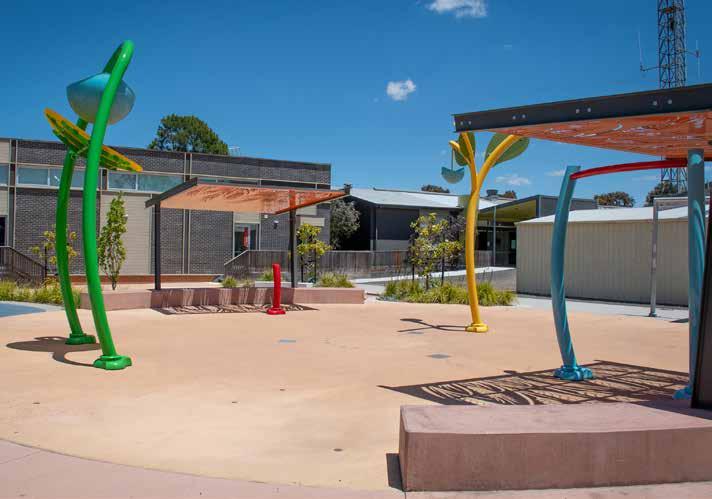
6 minute read
7. The Changing Shire
7.1 Challenges and Opportunities
Local, national and global trends all have the potential to impact the future outlook of Golden Plains. Council needs to understand these trends, harness their benefits and adaptively respond to preserve the health, vibrancy and resiliency of Golden Plains Shire.
Advertisement

Some of the main issues facing the provision of Council’s assets and services are outlined in Table 3.
Issue
Social Demand Population Trends
The present population of Golden Plains Shire is 24,249 people and is expected to grow to more than 42,193 people by 2041, This is a growth rate of around 2.6% per annum.
Demographic Change
By 2026, forecasts indicate a 15.0% increase in population under working age, a 45.6% increase in population of retirement age, and a 20.3% increase in population of working age. Change in the age structure of the population will mean it is critical for Council to plan age-based facilities and services.
Changing Community Needs
The community expects Council to be able to quickly respond to emerging needs, without knowing how long the demand might last.
Built Environment Ageing Infrastructure
One of the biggest financial challenges facing Council is the cost of renewing its ageing infrastructure. Council’s assets have been built and developed in the past. Many years on, this period of development has created a large peak in the need to invest in asset maintenance and renewal.
Rapid Technological Change
The world is becoming more connected. People, businesses and governments are increasingly moving online to connect, deliver and access services, obtain information and to perform day-to-day activities. These changes will affect how Council delivers services and how it manages its assets. The Council Plan 2021-2025 gives a basis for setting Council’s asset management objectives and defines asset requirements over the medium term.
What does this mean for asset management and service delivery?
Council will need to expand its services and assets to cater for its growing community. Council will need to make a financial investment in infrastructure so that its assets are of a suitable capacity to cater for growth and that exemplary urban renewal is achieved. The variable rate of growth across the Shire will impact the rate of demand for services and infrastructure across different districts.
A changing demographic will mean that Council will need to maintain a focus on providing assets that promote access and equity. Council will need to plan assets that are responsive and adaptable to meet shifting stakeholder needs. Council will need to seek to form strategic alliances with service delivery partners to enhance non-asset based service delivery solutions in turn optimising the use of Council’s asset portfolio.
Technological advancement is rapid, with digital technologies shaping and reshaping the way Council operates. There will be fundamental changes in the way stakeholders will engage with Council in the future. These changes will affect how services are delivered and, by extension, the facilities and assets that are needed.
Issue
Economic Demand Diminishing Income
The overall low rate environment due to rate-capping and potential freezing or reduction in grant funding may lead to a reduction in income available to Council.
Increasing Cost of providing Services
Cost increases to items such as electricity, petrol and raw materials impact on the Council. For the Council, this occurs within an expectation of doing more with less or improving efficiency to ensure more can be achieved with less money.
Delivering on Community Expectations while keeping it affordable
There is ongoing pressure from the community for higher quality assets and services to be provided for most Council activities. Smoother roads, modern technology and convenience are some examples. The expectation is for a higher level of service for the same amount of money – in other words, doing more with less.
Political and Regulatory Influence Legislative and Policy Influence
Council operates in a complex legislative and policy environment that directly influences the way it does business:
• There is an expectation that Council will continue to deliver services, even when State and Federal government funding is withdrawn. • The cap on rate increases means its ability to control revenue is constrained. • Compliance and reporting requirements are increasing.
What does this mean for asset management and service delivery?
Reduction in income due to rate-capping, availability of grant funding, and hardship responses to significant events such as the COVID-19 pandemic have the potential to materially affect Council’s financial sustainability. This will impact the way Council invests in its assets and services in the future. Council will need to aim to continually balance the affordable provision of services against the needs of the community.
Community expectations can be influenced by numerous drivers such as generational change, legislation, environmental standards, facilities experienced elsewhere and new technology. Council assets must cater for the expectations of the community by remaining accessible, well maintained and fit for purpose. Assets that meet these expectations cost money, and must be balanced and prioritised against building the Shire’s future and the ability of the community to pay.
Council needs to meet its statutory obligations while being conscious of maintaining affordability and financial sustainability. This requires good decisions to be made to manage competing funding demands across a broad range of projects, programs and services. Cost shifting by the Victorian and Federal Governments to the entire Victorian local government sector will continue. This will push Council to increasingly to rely on rates and charges only to fund existing and new services and programs.
Issue
Natural Environment Climate Change
Australia is already experiencing the impacts of climate change. In the future, it is expected to cause increased vulnerability to bushfire, storm damage to infrastructure, decreased water quality and security of water supply, and reduced summer outdoor activities due to higher temperatures.
Natural Hazards
The district is at risk from natural hazards such as flooding, landslips, storms and bushfire. These events can strike without warning. Such events can potentially cause significant unbudgeted costs, beyond the capacity of the Council to cope.
Table 3 - Summary of Key Challenges and Opportunities
What does this mean for asset management and service delivery?
Assets will need to be built and renewed to a standard that can withstand the impacts of climate change. This may require different materials, methods of construction and other innovative approaches. There may also be increased expectation for leadership from Council to make use of sustainable energy sources and to provide assets that are environmentally efficient. Council will need to give recognition to the upstream impacts of the materials and services we use in the design and construction of our infrastructure. The sourcing of more local, recycled content will minimise the use of virgin materials and reduce the amount of waste entering landfill. Council will need to recognise climate change risks and examine the vulnerability of our asset network. When disasters occur, Council needs to focus energy and resources on supporting the recovery of the community. Council assets will need to be rebuilt to a higher standard in the expectation that risks will only increase in the future.
7.2 Resilience in Challenging Times
Council’s community infrastructure assets are essential to the delivery of basic public services and even more so in changing urban landscapes. Council’s services face a multitude of potential risks, whether it is from poor planning, climate change or public health crises such as the ongoing COVID-19 pandemic. Good asset management lends itself to sound fiscal management by supporting long-term financial sustainability and ultimately ensuring that Council’s investment in its assets will adequately serve present and future generations. The COVID-19 pandemic has called for Council to be agile and flexible in the support of the community where most needed. Council has adapted to innovate new ways of keeping safe and connected while maintaining its high standard of service delivery. Council’s Asset Management Framework, including its systems, tools, and processes, means that Council is well positioned to act when needed. As the organisation’s asset management proficiency continues to improve so will the resilience of its assets and services to future threats and hazards.







